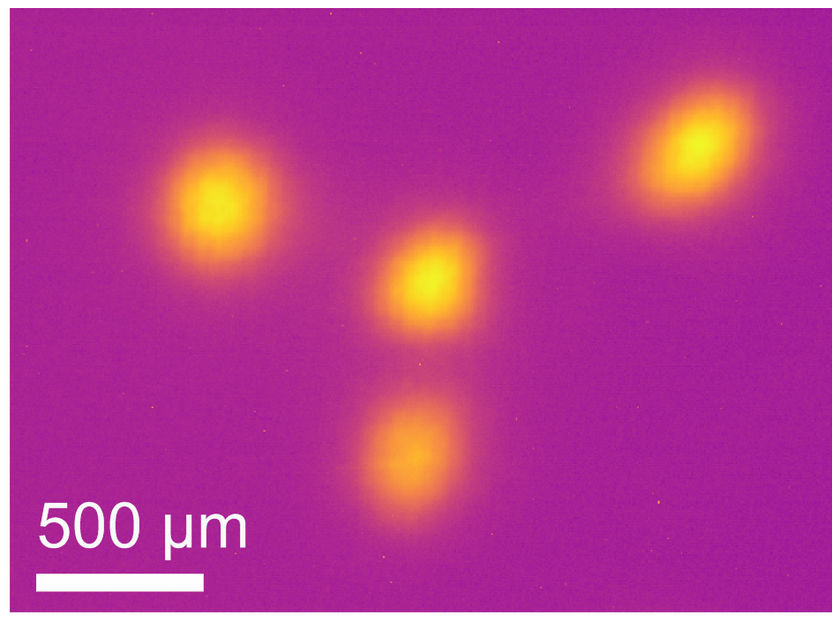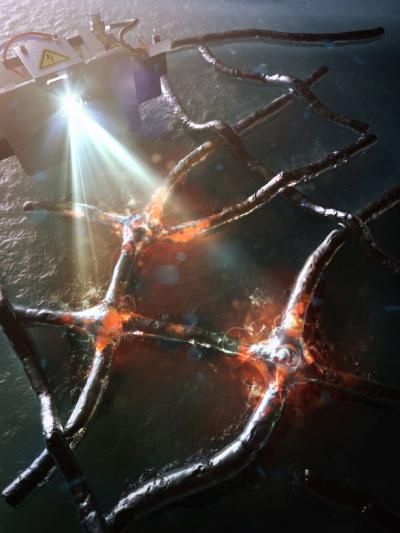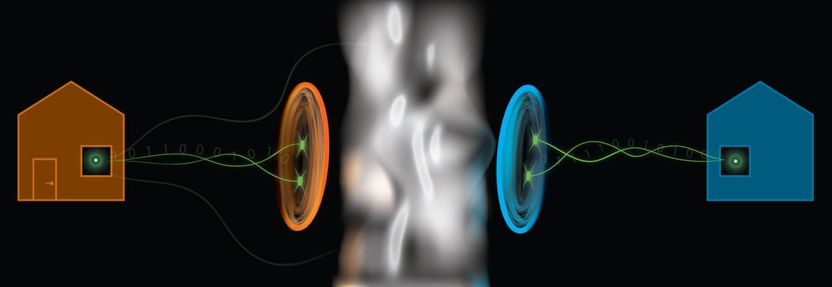Ultra-fast switching of helicity of circularly polarized light pulses
The ultra-fast change of light helicity is particularly interesting to observe processes in magnetic materials
At the BESSY II storage ring, a joint team of accelerator physicists, undulator experts and experimenters has shown how the helicity of circularly polarized synchrotron radiation can be switched faster - up to a million times faster than before. They used an elliptical double-undulator developed at HZB and operated the storage ring in the so-called two-orbit mode. This is a special mode of operation that was only recently developed at BESSY II and provides the basis for fast switching. The ultra-fast change of light helicity is particularly interesting to observe processes in magnetic materials and has long been expected by a large user community.

This picture shows an X-ray image of the electron beam in TRIB-mode where two orbits co-exist: the regular orbit and the second one winding around it closing only after three revolutions.
© F. Armborst/K. Holldack
In synchrotron radiation sources such as BESSY II, electron bunches orbit the storage ring at almost the speed of light. They are forced to emit extremely bright light pulses with special properties by periodic magnetic structures (undulators).
Experiments with polarized light pulses
Elliptical undulators can be used to generate also circularly polarized light pulses, which display a feature called helicity: the polarisation goes either clockwise or counterclockwise. Magnetic structures in materials react differently to circularly polarized light: Depending on the helicity of the X-ray pulses, they more or less absorb this radiation.
Since the 1980s, this has been exploited in so-called XMCD (X-ray Circular Dichroism) experiments to investigate static and dynamic changes in magnetic materials or to image magnetic nanostructures on surfaces.
Mapping dynamics in magnetic materials
Especially for such imaging techniques, the user community at synchrotron radiation sources has long wished for the possibility to quickly switch the helicity of the light, mainly because this directly results in a magnetic image contrast that makes bits in magnetic data storage devices visible and quantifiable.
In the elliptical undulators typical for BESSY II (APPLE II), developed by the group around Johannes Bahrdt, the helicity of light is switched by a mechanical displacement of meter-long arrangements of strong permanent magnets, a process that sometimes takes up to minutes.
Two orbits
The new method, however, is based on the combination of such undulators with a special orbit of the electron beam in the storage ring - generated by the so-called TRIBs (transverse resonance island buckets). TRIBs have been experimentally explored by the accelerator expert Dr. Paul Goslawski at BESSY II. While the path of the electrons in the storage ring normally closes after one orbit, in the TRIBs mode the electrons run on different orbits during successive orbits and can thus emit X-ray pulses from different magnetic field configurations, suggested Dr. Karsten Holldack and Dr. Johannes Bahrdt.
And it works
They were recently able to show that their idea actually works with the help of the existing double undulator UE56-2 at BESSY II in a pilot experiment: When passing through a specially prepared magnet arrangement of this double undulator, the electron bunches from different orbits in TRIBs mode emitted X-ray photons with the same wavelength but opposite circular polarization.
Switching a million times per second
Thus, in principle, XMCD signals from magnetic samples can now be studied at intervals of only 1 microsecond with right- and then left-circularly polarized light pulses. In the pilot experiment the XMCD signals from a magnetic sample (nickel in permalloy) were detected from revolution to revolution and the fast (MHz) helicity change could be clearly demonstrated. With new undulators tailored for this purpose, special beamlines with ultrafast helicity change could be offered at BESSY II in TRIBs mode. Ultimately switching times could shrink to nanoseconds.
Outlook: BESSY III
”We are really delighted that the Two-Orbit / TRIBs development allows now already new experiments at BESSY II”, Goslawski says. This would also be an attractive option for BESSY III.
Original publication
Karsten Holldack, Christian Schüßler-Langeheine, Paul Goslawski, Niko Pontius, Torsten Kachel, Felix Armborst, Markus Ries, Andreas Schälicke, Michael Scheer, Winfried Frentrup and Johannes Bahrdt; "Flipping helicity of X-rays from an undulator at unprecedented speed"; Nature Communications Physics; 2020
Most read news
Original publication
Karsten Holldack, Christian Schüßler-Langeheine, Paul Goslawski, Niko Pontius, Torsten Kachel, Felix Armborst, Markus Ries, Andreas Schälicke, Michael Scheer, Winfried Frentrup and Johannes Bahrdt; "Flipping helicity of X-rays from an undulator at unprecedented speed"; Nature Communications Physics; 2020
Organizations
Other news from the department science

Get the chemical industry in your inbox
By submitting this form you agree that LUMITOS AG will send you the newsletter(s) selected above by email. Your data will not be passed on to third parties. Your data will be stored and processed in accordance with our data protection regulations. LUMITOS may contact you by email for the purpose of advertising or market and opinion surveys. You can revoke your consent at any time without giving reasons to LUMITOS AG, Ernst-Augustin-Str. 2, 12489 Berlin, Germany or by e-mail at revoke@lumitos.com with effect for the future. In addition, each email contains a link to unsubscribe from the corresponding newsletter.
Most read news
More news from our other portals
Last viewed contents
Hi-School_Pharmacy
Muhammed_ibn_Umail_al-Tamini
Particle_in_a_one-dimensional_lattice_(periodic_potential)

Improving silver nanowires for FTCEs with flash light interactions
Enovate
Proton-proton_chain_reaction

Trends in Analytics: Digitization, detecting novel pollutants and more - analytica 2018




























































